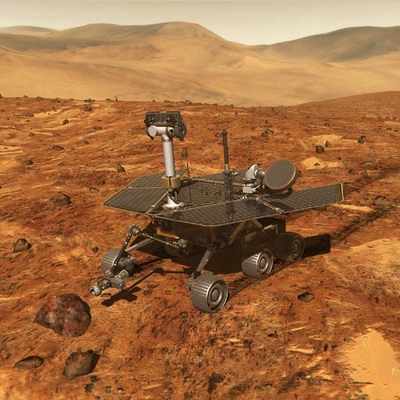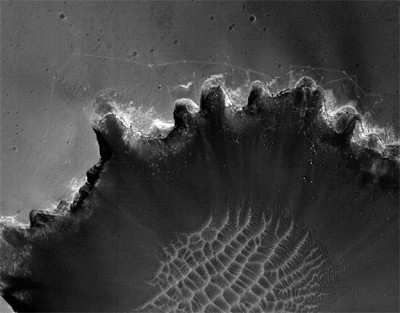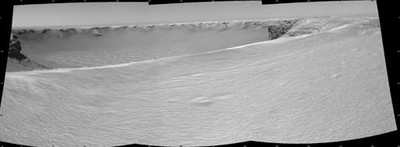Never-Say-Die Spacecraft Survive Dust Storms
Two months after sky-darkening dust from severe storms nearly killed NASA's Mars exploration
rovers, the space agency reports its solar powered
robots are awake and ready to continue their mission.

Opportunity's planned descent into the giant Victoria Crater was
delayed, but now the rover is preparing to drive into the
800-meter-diameter crater (half-mile-diameter) as early as Tuesday,
according to NASA.
Spirit, Opportunity's rover twin, also survived the global dust
storms. The rovers are 43 months into missions originally planned
to last three months. On September 5, Spirit climbed onto its
long-term destination called Home Plate, a plateau of layered
bedrock bearing clues to an explosive mixture of lava and
water.
"These rovers are tough. They faced dusty winds, power
starvation and other challenges -- and survived. Now they are back
to doing groundbreaking field work on Mars. These spacecraft are
amazing," said Alan Stern, associate administrator of NASA's
Science Mission Directorate, Washington.
Victoria Crater (below) contains an exposed layer of bright
rocks that may preserve evidence of interaction between the Martian
atmosphere and surface from millions of years ago, when the
atmosphere might have been different from today's. Victoria is the
biggest crater Opportunity has visited.

Martian dust storms in July blocked so much sunlight that
researchers grew concerned the rovers' daily energy supplies could
plunge too low for survival. Engineers at NASA's Jet Propulsion
Laboratory, Pasadena, Calif., put Opportunity onto a very
low-energy regimen of no movement, few observations and reduced
communication with Earth. Skies above both rovers remain dusty but
have been clearing gradually since early August.
Dust from the sky has been falling onto both rovers' solar
panels, impeding their ability to collect energy from the sun.
However, beneficial wind gusts removed some of the new buildup from
Opportunity almost as soon as it accumulated.
 Opportunity drove to the lip of
Victoria Crater in late August and examined possible entry routes.
This week, Opportunity has been driving about 40 meters (about 130
feet) toward its planned entry point. The route will provide better
access to a top priority target inside the crater: a bright band of
rocks about 12 meters (about 40 feet) from the rim. "We chose a
point that gives us a straight path down, instead of driving
cross-slope from our current location," said Paolo Bellutta, a JPL
rover driver plotting the route. "The rock surface on which
Opportunity will be driving will provide good traction and control
of its path into the crater."
Opportunity drove to the lip of
Victoria Crater in late August and examined possible entry routes.
This week, Opportunity has been driving about 40 meters (about 130
feet) toward its planned entry point. The route will provide better
access to a top priority target inside the crater: a bright band of
rocks about 12 meters (about 40 feet) from the rim. "We chose a
point that gives us a straight path down, instead of driving
cross-slope from our current location," said Paolo Bellutta, a JPL
rover driver plotting the route. "The rock surface on which
Opportunity will be driving will provide good traction and control
of its path into the crater."
For its first foray into the crater, Opportunity will drive just
far enough to get all six wheels in; it will then back out and
assess slippage on the inner slope. "Opportunity might be ready for
that first 'toe dip' into the crater as early as next week," said
JPL's John Callas, rover project manager. "In addition to the
drives to get to the entry point, we still need to conduct
checkouts of two of Opportunity's instruments before sending the
rover into the crater."
The rover team plans to assess if dust has impaired use of the
microscopic imager. If that tool is working, the team will use it
to observe whether a scanning mirror for the miniature thermal
emission spectrometer (Mini-TES) can function accurately. This
mirror is high on the rover's camera mast. It reflects infrared
light from the landscape to the spectrometer at the base of the
mast, and it also can be positioned to close the hole in the mast
as protection from dust. The last time the spectrometer was used,
some aspects of the data suggested the instrument may have been
viewing the inside of the mast instead of the Martian
landscape.
"If the dust cover or mirror is no longer moving properly, we
may have lost the ability to use that instrument on Opportunity,"
said Steve Squyres of Cornell University, Ithaca, NY, principal
investigator for the rovers' science instruments. "It would be the
first permanent loss of an instrument on either rover. But we'll
see."

The instrument already has provided extensive valuable
information about rocks and soils in the Meridiani region where
Opportunity works. "Mini-TES has told us a lot about the rocks and
soils at Meridiani, but we've learned that the differences among
Meridiani rocks are often too subtle for it to distinguish,"
Squyres said. "The same instrument on Spirit, at Gusev Crater, has
a much more crucial role for us at this point in the mission
because there is such diversity at Gusev." Researchers will rely
heavily on a different type of instrument, Opportunity's alpha
particle X-ray spectrometer, for analysis of rocks at the
bright-band target layer in the crater.
 Senator Pushes FAA to Accelerate Rocket Launch Licensing
Senator Pushes FAA to Accelerate Rocket Launch Licensing Classic Aero-TV: RJ Gritter - Part of Aviations Bright New Future
Classic Aero-TV: RJ Gritter - Part of Aviations Bright New Future Aero-FAQ: Dave Juwel's Aviation Marketing Stories -- ITBOA BNITBOB
Aero-FAQ: Dave Juwel's Aviation Marketing Stories -- ITBOA BNITBOB ANN's Daily Aero-Linx (10.27.24)
ANN's Daily Aero-Linx (10.27.24) ANN's Daily Aero-Term (10.27.24): Clearance Void If Not Off By (Time)
ANN's Daily Aero-Term (10.27.24): Clearance Void If Not Off By (Time)






